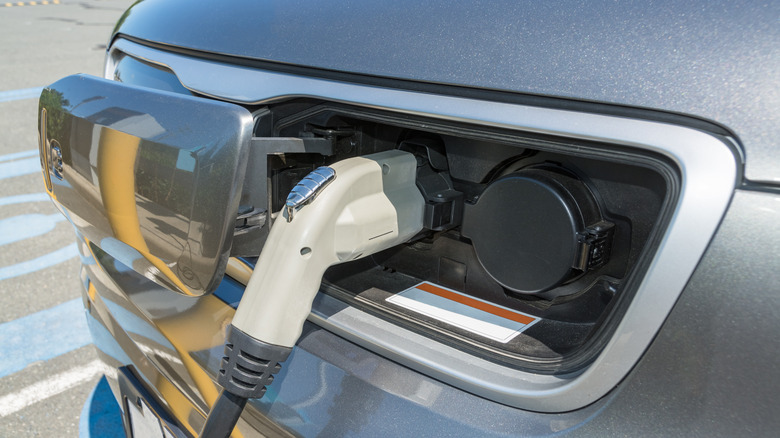The Big Myth About Charging Technology You Should Stop Believing
We may receive a commission on purchases made from links.
The average consumer will replace a smartphone 2.6 years after buying it (via Statista). If you have a laptop, you can expect it to last at least 4 to 7 years before you need an upgrade, according to Tech Guided. However, the lifespan of your smartphone, laptop, and even your electric vehicle depends on the battery's health. In fact, fewer people tend to upgrade their smartphones if they have an option to replace the battery – Apple found this out after a loss in its revenue.
Of course, batteries are not meant to last forever but you can make them last longer by avoiding bad charging habits that could accelerate the degradation process. Most of those charging habits are propagated by the myths we tell ourselves — At first, they may seem harmless but they can gradually reduce the lifespan of your batteries or devices. Let's dig deeper and debunk the myths about charging technology you should stop believing.
Myth: The battery shouldn't be charged unless it's at 0%
Most smartphones come with lithium-ion batteries that will deplete after 400 to 500 charge cycles. According to Apple, one charge cycle of your battery is complete after you've consumed 100% of its capacity. However, the 100% battery capacity doesn't need to be depleted from 100% to 0% to constitute a single charge cycle. More succinctly, if you drain your battery by 60% and you recharge it to full capacity, you will complete one charge cycle after you've consumed another 40%. That means the battery will still complete its charge cycle whether or not it drains to 0%.
Beyond that, research says that letting your battery drain to 0% could do more harm than good. "It is possible to prolong the battery life by not completely charging and not completely discharging," Hans de Vries, senior scientist at Signify, told The New York Times. So, what's the ideal charge you should target? The sweet spot is to plug your device with a lithium-ion battery (smartphone, laptop, or electric vehicle) into the charger after the charge drops to 20% and then unplug it at 80%.
Myth: Charging overnight could overload your battery
Contrary to what some people believe, charging your smartphone, laptop, or electric vehicle overnight won't overload the battery. This is because most modern devices that use lithium-ion batteries are designed with smart chips that will automatically cut off the power supply at 100% (via Time). However, once the device stops charging, the battery charge can drop slightly after a few minutes, prompting the charger to resume and return to 100%. This small power gain is known as "trickle charge" and it could reduce the lifespan of your battery.
To prevent the trickle charge effect, the latest iPhone and Android smartphones have an optimized battery charging feature. For instance, if you activate optimized battery charging on your iPhone, it will stop the power supply at 80% and accelerate the charge to 100% a few minutes before you wake up (via 9To5Mac). In other words, the battery doesn't trickle charge, and you can easily predict when the battery charge will be at 80% if you want to unplug it to increase its lifespan.
Myth: You shouldn't use your phone while it's charging
According to Samsung, it's safe to use your smartphone while it's still connected to the charger. The same case applies to laptops and electric vehicles. If you're using a smartphone while it's plugged into a charger, the charge rate will slow down so it doesn't interfere with your power consumption.
Nonetheless, you should be careful to avoid playing video games and streaming HD videos on your smartphone when it's charging, according to Huawei. If you do so, you could cause the battery to overheat which could shorten its lifespan. But if you're accessing apps that don't consume a lot of power, it should be okay to use your smartphone while it's plugged in. If you notice your device is too hot, you should unplug it from the charger.
Besides that, the ambient temperature to charge your lithium-ion battery should ideally be between 50 degrees and 86 degrees F (via Battery University). However, different manufacturers have different recommendations. For example, Tesla recommends that you plug in your vehicle to the charger as much as possible during winter to keep the battery warm.
Myth: Fast charging will damage your battery
As technology is advancing, a lot of smartphones, laptops, and electric vehicles nowadays can charge from 0% to 80% in just a few minutes. For instance, the Vivo iQOO 7 can charge from 0% to full capacity in about 18 minutes — this makes it one of the fastest charging smartphones ever made. Also, level 3 fast chargers for EVs can provide up to 120 miles of range in 20 minutes or less. Of course, with such super-fast charging speeds, it's not unusual to think the battery could degrade.
But the fact is, fast charging won't harm your battery. If you have a fast charging device, you will notice the charge speed will slow down after 50% or 80%. According to Belkin, the power voltage will reduce after the first phase, usually at 50% or 80%, to prevent the battery from overheating. This means that fast charging your smartphone, laptop, or EV should be safe unless there is a hardware or software flaw that doesn't reduce the voltage to regulate the temperature. It's also important that you choose a suitable fast charger for your device.




